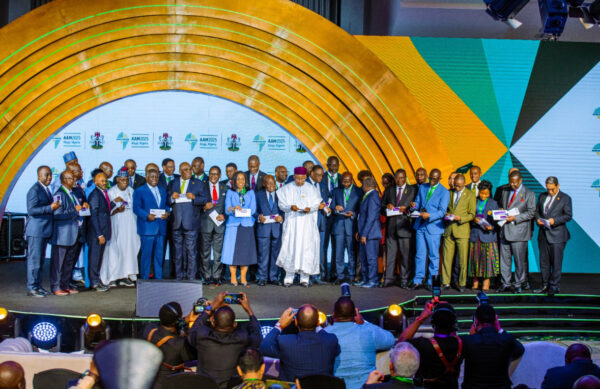As the curtain falls on Professor Benedict Oramah’s presidency, the numbers and achievements attest to a profound transformation of Afreximbank, both financially and strategically. At the helm of the institution since June 2015, the Nigerian economist leaves behind a solidly capitalized bank, expanded in its missions, and has become essential in the African financial landscape.
Unprecedented financial results
Between September 2015 and April 2025, Afreximbank’s assets and guarantees multiplied by eight, reaching $43.5 billion. Annual revenue increased from $408 million to $3.24 billion, while net profit reached $1 billion in 2024, compared to $125 million a decade earlier. Equity jumped from $1 to $7.5 billion, driven by massive capital mobilization and renewed shareholder confidence.
This solid progression was praised in a recent report by Fitch, which highlighted the quality of assets, the diversification of funding sources, and Afreximbank’s ability to withstand external shocks. The agency considers the institution a major systemic player in African financial architecture.
A role as a systemic stabilizer
Afreximbank has emerged as the main instrument for responding to economic crises on the continent. From the drop in commodity prices in 2015 to the COVID-19 pandemic, and then the war in Ukraine, the bank mobilized over $70 billion to maintain the resilience of African economies. It has facilitated access to vaccines, secured critical imports, and supported recovery plans.
An industrial and pan-African ambition
The Oramah mandate has been marked by a constant desire to relocate value chains. Support for industrial infrastructure, such as the Dangote petrochemical complex or the Arise IIP special economic zones, is a direct response to the continent’s dependence on imports. The bank aims for 100,000 hectares of industrial zones by 2030.
Health has also been a priority with the opening of the first African Medical Center of Excellence in Abuja, endowed with $300 million and backed by a $600 million research fund.
Towards monetary integration
Under Oramah, Afreximbank launched PAPSS, a pan-African payment system in local currencies, operational in 16 countries. This is complemented by a pan-African payment card, an intra-African foreign exchange market, and initiatives such as the transit guarantee system or technical standardization across the continent.
The intra-African trade financing rate has thus increased from 3% in 2015 to 32% in 2024, a transformation that supports the concrete implementation of the AfCFTA.
A major challenge for the next decade
Despite these major advances, one of the main challenges remains mobilizing long-term concessional resources in a context of drastic reduction in official development assistance and geopolitical fragmentation. Afreximbank’s concessional financing unit will need to be strengthened to ensure access to affordable capital, especially for low-income countries and long-maturity projects.
A strategic legacy
With over $155 billion invested in ten years, Benedict Oramah leaves behind a transformed institution capable of global ambitions. His doctrine of “African best practice,” based on capital mastery, speed of execution, and continental solidarity, represents a deliberate shift from Western standards.
His successor will now have to consolidate these achievements while preparing Afreximbank for the next level: reaching $250 billion in assets, according to the goal set for 2035. A bold gamble in an increasingly uncertain world, but one to which Oramah has laid a solid foundation.
Photo caption
Prof. Benedict O. Oramah, President and Chairman of the Board of Afreximbank, with former African Heads of State at the inaugural ceremony of the 32nd Annual Meetings of the Bank, held in Abuja, Nigeria, on June 26, 2025.


